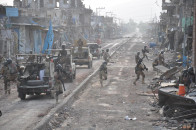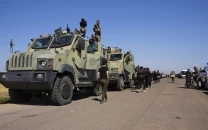Walking wounded
While victims of terrorism are mourned, it is survivors who suffer most.

The chilling fiction of “organic shrapnel” was created by American writer Don DeLillo in his post-9/11 novel Falling Man that was published in 2007. His concept referred to the pieces of human flesh that embed in another person’s skin right after an explosion. Imagine, you could be walking around with pieces of a suicide bomber in you.
There is no scientific research, especially in Pakistan, to testify to the veracity of this phenomenon. But it is perhaps not far from the reality of the people who have survived bomb blasts either injured or unscathed. Those events leave them scarred in ways that the rest of us cannot even begin to imagine.
Thirty-six-year-old Faraz cannot have children now. Over five years ago, he was at Nishtar Park to take part in the celebrations for the Holy Prophet’s (PBUH) birth anniversary. A suicide bomber targeted the crowd, killing dozens. Faraz was hit by ball bearings in the arm, twice in the leg by the knee and once near the groin. He had been married barely five months. Injuries from bullets are worse than those from shrapnel, argues Dr Saeed Quraishy, who is the medical superintendent of Civil hospital that has seen its fair share of patients from terrorist attacks in the last decade.
“It mainly depends on the person’s proximity to the origin of the blast,” he explains. “Obviously closer proximity means greater and more extensive damage.” The lead of a bullet also has significant long-term effects compared to steel or metal from shrapnel or ball bearings. Suicide attacks in Islamabad became more frequent after 9/11 with the highest number of attacks taking place in 2007, according to the South Asia Terrorism Portal (satp.org). Since 2007, over 425 people have been injured in suicide attacks in the city. If these numbers are accurate, we can only assume that these survivors are the ones who struggle with their scars every day.
The nature of bombs is such that even if you walk away from one unscratched, there is no telling what they will do to you internally and psychologically. “When a bomb explodes there is a sudden massive release of energy which causes the disruption of tissues and a change in atmospheric pressure [negative pressure is created],” says Qudsia Hassan, who is an associate professor for forensic medicine at Ziauddin University. “This is followed by a wave, vacuum and then another wave. This sudden change can and does adversely affect a person’s organs, particularly the ears, lungs and intestines as they are two interface mediums.” Two interface mediums refer to organs that interact with air as well as the blood in order to function normally. Other organs, which are relatively less affected, are the liver and spleen. The ordeal of the attack does not stop at the survivor either. After their son Asad was injured in an attack at Ali Reza Imambargah, his parents spent four gruelling months by his bedside while he recovered from the burns. “We didn’t expect him to survive but by some miracle he did,” his mother told The Express Tribune. Asad’s body still bears the marks, a daily reminder of what he has lived through. “There were days when I thought I would rather die than live with the pain anymore,” he said.
“I figured that if I did survive, life would never be the same. In fact, it might be living hell. Will I be able to walk, work and do other normal things became a big question mark.” Indeed, the people who survive terrorist attacks only to emerge with some physical or functional losses are the ones who are the worst impacted. “It is not just the survivor but also their relatives, more so if it is a facial deformity in women,” says Prof. Dr Iqbal Afridi, who heads the department of psychiatry at Jinnah Postgraduate Medical Centre. These people are likely to struggle with acute stress syndrome and post-traumatic stress disorder. For example, in Faraz’s case the inability to have children plays on his mind. However, Dr Afridi stresses that family and emotional support can be crucial elements in helping someone overcome the memory of the incident and the pain.
Family support was perhaps what brought Asad back from the brink. Today, he is happily married and living in Dubai where he works in finance. He sums it up: “It was my parents’ will and love that wouldn’t let me lose hope.”
Organic Shrapnel
What would happen if, theoretically speaking, the terrorist attacker was infected with AIDS? Would he not infect a victim if he blew himself up and pieces of his ‘organic shrapnel’ embedded in their skin? There is no scientific evidence to substantiate this and some experts do not seem convinced that it holds water. “Suicide bombers are usually the healthiest and the most fit of the lot,” explains an official from the police surgeon’s office. “Terrorists don’t want to send weaklings or those infected with diseases to execute such plans as they could end up getting caught and could reveal details about them and their operations. Thus, the possibility of the transmission of harmful diseases is very rare.”
Dr Qudsia agrees but is sceptical. “There is a good possibility of transmitting HIV/AIDS and other infectious diseases [in suicide attacks] but there is no literature or academic research available in Pakistan to make an authoritative comment.”
Published in The Express Tribune, December 15th, 2011.



















COMMENTS
Comments are moderated and generally will be posted if they are on-topic and not abusive.
For more information, please see our Comments FAQ